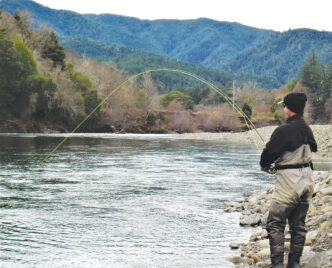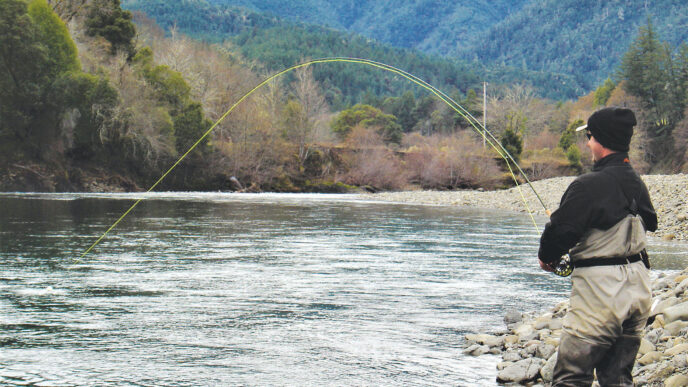Bouncing Betty was conceived on the Madison River in July of 2011. Lisa and I had just purchased a very expensive steel-clad, lead-filled river anchor for the raft, and on its maiden deployment, the carabiner bent open and dumped the anchor into the deepest, fastest run in the river. The following day we returned, and I spent several hours hanging onto anchored ropes, wearing a dry suit and a 40-pound weight belt. I scoured the bottom in a grid fashion, but never found the anchor. What I did find was an unbelievable number of stonefly nymphs residing beneath the boulders in the swiftest current that the river could deliver.
Dense clouds of stonefly nymphs (primarily Pteronarcys) erupted from beneath each and every boulder I dislodged during the search. As they tumbled in the fast current, their white gills flashed against their black bodies. The river was faster and deeper than we would ever sample in a simple benthic macroinvertebrate kick-net sample. Black nymphs from a quarter of an inch to two inches in length jettisoned from the streambed like clouds of ink from a squid. In a primal sense, it was creepy to be enveloped in this density of insect larvae.
It also was an awakening. In nearly 40 years of snorkeling and scuba diving rivers, I had never “sampled” the deepest and fastest sections. I had always believed that macroinvertebrates prefer the runs, shallower riffles, and calmer sections of the water, rather than the deep, churning sluice boxes. In terms of biomass, nothing could be further from the truth, and I have since seen the same phenomenon on other rivers.
The problems of effectively fishing a large nymph in the very fast, 6-to-10-foot-deep water that these bugs choose to call home are several, the most obvious being how to get the nymph to the bottom before it gets spat downstream. A chain of split shot works, but they kill any tactile sense between the angler and the fly. A hookup is simply a matter of luck, and I know from being underwater and watching fish feed on nymph imitations that only a small fraction of the takes result in an accidently hooked fish if the hook isn’t set. Sinking and sink-tip lines are often recommended, but in truth, they deaden the grab even more than a chain of shot. Shot at least keeps the line taut, but fat fly lines get buffeted by the current and introduces a bunch of slack in the system. The answer is a nymph that sinks like my anchor did.
Bouncing Betty is tungsten and lead overwrapped with brass, and any accoutrements are kept to a bare minimum. Every antenna, leg, and tail will create added drag on the drop. The two white biots on the Betty are tied tight to the body to avoid drag. The collar is a single wrap of very sparse dubbing to subdue the outline with a soft halo. The pattern needs to be cheap and dirt simple to tie, since it is designed to bounce among the boulders, where it frequently will be lost to snags. The Copper John, another wire nymph designed to sink like a rock, is far too complex for my tastes.
To cut through the water, I use an appropriate length (the length of the rod is a good starting point) of the skinniest tippet I can get away with. (4X is a good place to start.) No taper is needed, because the weight of the fly turns it over. I normally fish two nymphs about 18 inches apart. A long, sensitive rod such as a European-style nymphing rod (I use a domestically-made 4-weight 10-foot version) is a huge bonus not only for feeling the fly scratch the bottom, but to get extra lift on the mends and extra reach for the high-sticking that I almost always employ. I also use a Euro-nymph line, which is skinny to cut through the water and stiff to reduce sag between the guides and between the rod tip and the water’s surface. These qualities make a big difference, compared with a standard fly line.
If this all sounds specialized, it is, and I resisted going this direction for a long time. I now regret not putting together such a nymph rig sooner. It has put me into hundreds of fish that I would never have otherwise touched.
Materials
Hook: Tiemco 2457, size 8 to 18
Thread: Black UNI 3/0
Bead: Black tungsten, countersunk, 4 millimeter to 2 millimeter, depending on the hook
Lead: .020-inch to .035inch lead wire, depending on the hook
Wire: Medium black Ultra Wire
Wings: White goose or turkey biots. Clear epoxy or UV glue, if desired.
Collar: Brown Hareline Ice Dub
Tying Instructions
Step 1: Crimp the barb and slide the bead onto the hook, concavity toward the rear.
Step 2: Wrap the lead on the shank from the barb to the back of the bead.

Step 3: Tie on the thread where the hook starts to bend and build up a tapered ramp from the shank to the lead. Completely cover the lead to make a smooth black body.

Step 4: Tie in the Ultra Wire atop the lead behind the bead. Secure the wire all the way to the thread tie-in point. Whip finish the thread and snip it to get it out of the way. Of course, you can wrap the thread back to the bead, where it will be waiting for Step 6.
Step 5: Wrap the wire forward to the bead. Make the wraps as snug together as possible.
Step 6: Remount the thread and tie in a pair of white biots at the base of the bead so the tips extend to the bend of the hook. For best sinking, tie the biots flush to the wire, rather than allowing them to flare. You can add a drop of epoxy or other hard, clear adhesive over them. It looks nice and holds them down, but I don’t bother unless I’m feeling extra anal that day.

Step 7: Spin a sparse tuft of dubbing on the thread and make a sparse collar at the base of the bead to hide the biot butts and make a finished connection between the body and the bead. Pluck out some of the fibers to create a fine halo over the body. Whip finish the thread behind the bead. I normally do two four-wrap whips, because I don’t use head cement for fear of getting it into the dubbing.















